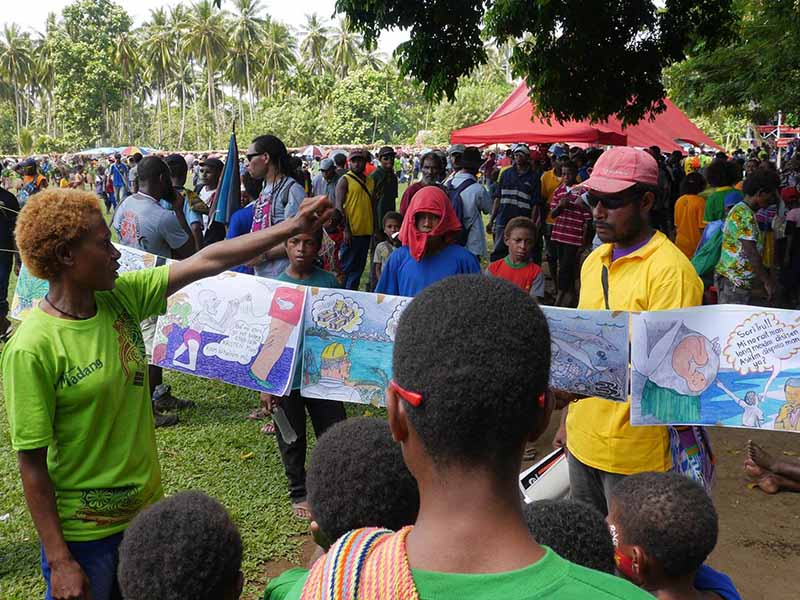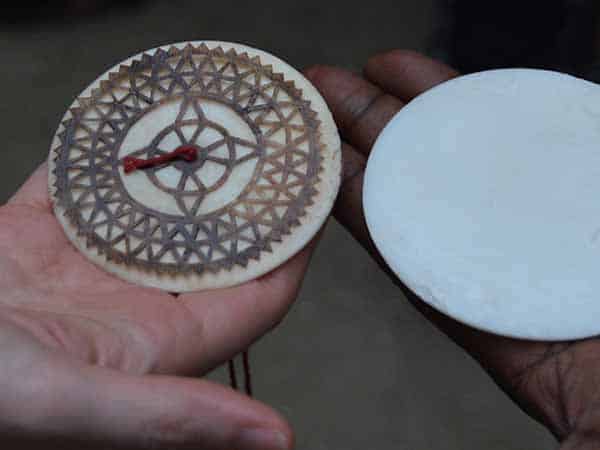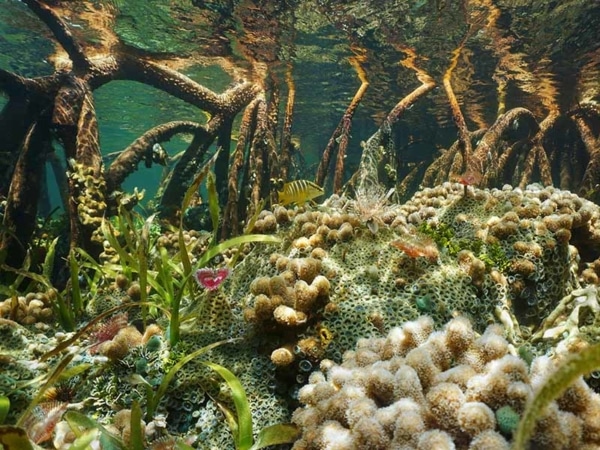Ocean: Communities and Culture
The ocean plays a fundamental role in the cultures and identities of people the world over. From the strong links between cultural identity and fishing in coastal towns in the United Kingdom, to the closure of fisheries to mark the death of a community member in Papua New Guinea, to the ancient voyaging tradition of Polynesian islands, where long-distance ocean journeys are carried out on traditional outrigger boats, using navigation techniques which have been passed down from generation to generation: this relationship to the ocean is deeply ingrained in human cultures.
We are promoting effective ocean conservation by:
Assisting communities in their work to secure rights to use and manage marine areas.
 A crowd outside (perhaps a festival) with children and adults. In the foreground is a washing line with colourful hand-drawn posters showing people speaking out against deep-sea mining
A crowd outside (perhaps a festival) with children and adults. In the foreground is a washing line with colourful hand-drawn posters showing people speaking out against deep-sea mining
Securing rights has been widely recognised as a key step in enabling rights-holders to think and act for the long-term on their lands and waters.
Supporting community-led marine conservation or small-scale fisheries management initiatives.
We help to provide the capacity and resources to groups on the ground to focus on enabling local leaders and communities to carry forward urgent work to improve local ocean health and livelihoods.
 Two children staring into a rockpool
Two children staring into a rockpool
Supporting the revitalisation, celebration and regeneration of sacred sites, rituals, languages, and practices that are linked to the ocean.
 A close-up of the face of a painted wooden Malagan carving with strong use of shapes (circular eyes, triangular nose), two long feather-like structures either side of the head and a bunch of sticks growing out of the head
A close-up of the face of a painted wooden Malagan carving with strong use of shapes (circular eyes, triangular nose), two long feather-like structures either side of the head and a bunch of sticks growing out of the head
The fundamental link between ocean health and human health and wellbeing is kept alive and strengthened by diverse cultures, but many of these cultures are under threat.
* Images (L to R): Bismarck Ramu Group; Synchronicity Earth; Wikimedia Commons
“These are our people, it is our culture, we cry with them, we sleep in their houses, we do customs with them. We will be there forever.”
– John Aini, Indigenous Leader, New Ireland Province, Papua New Guinea, speaking as the Founder of Ailan Awareness
Revitalising cultural practices
Partner Profile: Ailan Awareness
Ailan Awareness is a Papua New Guinean organisation that focuses on strengthening Indigenous sovereignty with regard to both biological and cultural diversity in New Ireland, Papua New Guinea.
Ailan Awareness empowers coastal communities to manage their marine and cultural resources using a mix of traditional and scientific methods, giving priority to strengthening Indigenous conservation methods.
Working at a grassroots level, Ailan Awareness gives the people most directly affected by declining biodiversity and the loss of tradition the support and tools required to design and carry out the conservation of both biological diversity and traditional cultural practices. Linking these two components helps to empower communities to maintain Indigenous sovereignty over both. For example, Ailan Awareness is now working to revitalise the local cultural practice of ‘Malagan carving’, a type of wood carving produced by local Indigenous Peoples that communicates deep guidance around traditional ways of life and connection to the natural world.
 Two hands, one light-skinned and one dark-skinned, holding two round objects. In the left hand the object is wooden and appears to have a piece of red thread tied in a knot through the middle, and a dark symmetrical pattern around it. The other round object is plain white with no markings.
Two hands, one light-skinned and one dark-skinned, holding two round objects. In the left hand the object is wooden and appears to have a piece of red thread tied in a knot through the middle, and a dark symmetrical pattern around it. The other round object is plain white with no markings.
A kapkap, carved out of turtle shell in New Ireland, Papua New Guinea, is a traditional head ornament. Image: Ailan Awareness
“Undervaluing nature is one of the biggest threats, and it’s cross-cutting, because it affects not just the environment, but also social norms – it alters the community’s perception of what should be important and opens the door for other ways of thinking and other values (…) I think some of the ‘modern’ ways of life coming in can make new generations slightly out of touch with their cultural heritage.”
– Miriam Supuma, Progamme Manager, Biological Diversity Programme
Our Ocean Programme
 A close-up of the face of a painted wooden Malagan carving with strong use of shapes (circular eyes, triangular nose), two long feather-like structures either side of the head and a bunch of sticks growing out of the head
A close-up of the face of a painted wooden Malagan carving with strong use of shapes (circular eyes, triangular nose), two long feather-like structures either side of the head and a bunch of sticks growing out of the head
Communities and Culture
Supporting community-led marine conservation, rights and culture.
 An underwater photo with mangrove tree roots and rich coral life with one yellow striped fish
An underwater photo with mangrove tree roots and rich coral life with one yellow striped fish
Species and Ecosystems
Protecting overlooked and underfunded species and ecosystems.
 Five people sitting at a long wooden table with their laptops, some of them wearing white devices over their ears, there are wooden signs in front of the people with the names of their organisations and one of them appears to be watching something happening on the other side of the room
Five people sitting at a long wooden table with their laptops, some of them wearing white devices over their ears, there are wooden signs in front of the people with the names of their organisations and one of them appears to be watching something happening on the other side of the room
Research and Policy
Supporting systemic change through better policy and implementation.
